Menus
- Tourers from BMW, Kawasaki, Yamaha and Honda in comparison
- MOTORRAD Tourer rating and test result
- Technical data – BMW, Honda
- Technical data – Kawasaki, Yamaha
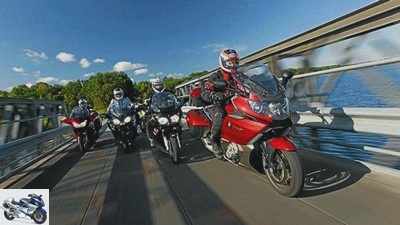
Artist
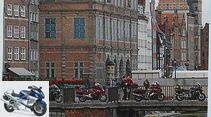
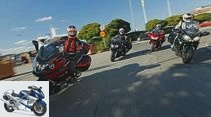

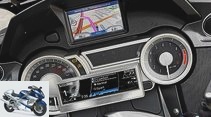
21st photos
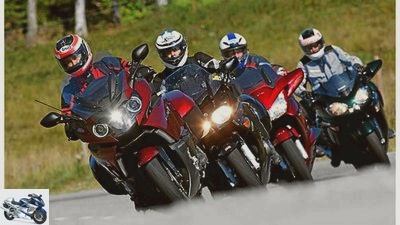
1/21
The story of a seven-day trip with a simultaneous comparative test around the Baltic Sea with the tourers: BMW K 1600 GT, Kawasaki 1400 GTR, Yamaha FJR 1300 A and Honda Pan European.
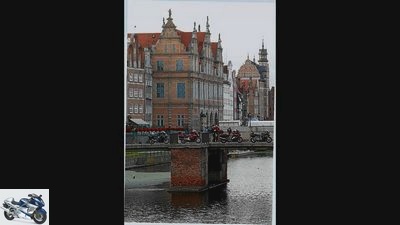
2/21
Impressive: the old town of Gdansk.
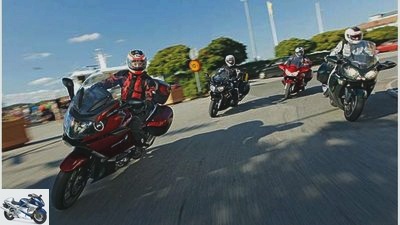
3/21
BMW K 1600 GT, Kawasaki 1400 GTR, Yamaha FJR 1300 A and Honda Pan European.
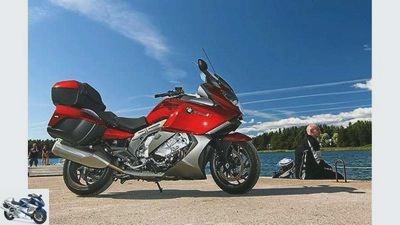
4/21
The BMW K 1600 GT.
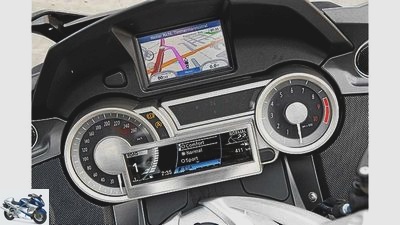
5/21
No other program offers such a comprehensive and easy-to-use information program, only BMW.

6/21
The luggage system of the K 1600 GT is sophisticated and has practical dimensions.
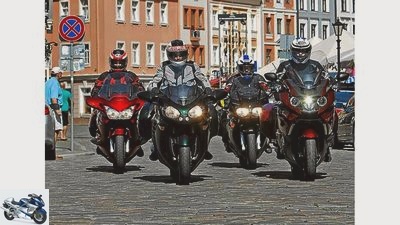
7/21
Well worth a trip: Riga with its historic old town and a lively bar scene.

8/21
On the way from Gdansk to Riga, innumerable stork nests line the way.
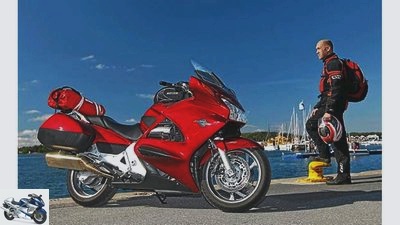
9/21
The Honda Pan European.
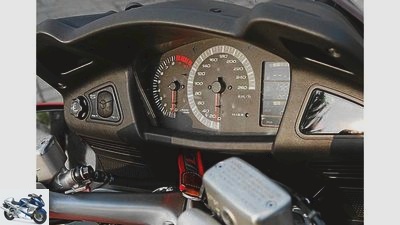
10/21
The Honda cockpit is clear, but does not offer the flood of information from BMW. And not even a gear indicator.
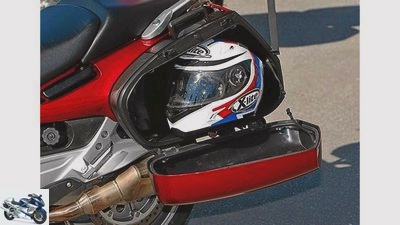
11/21
The Honda cases have even more volume than their BMW counterparts, but the tapered shape is impractical.
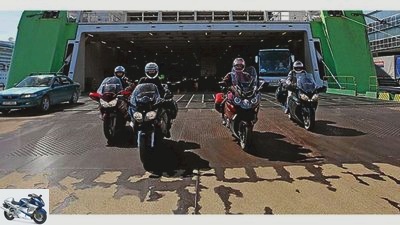
12/21
Welcome to Scandinavia: after a two-hour drive, the ferry from Tallinn docks in Helsinki.
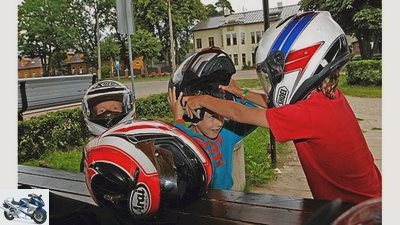
13/21
The boys are enthusiastic about the tourers.

14/21
The Kawasaki 1400 GTR.
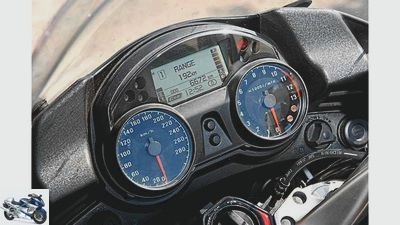
15/21
Complete, but not user-friendly. The Kawasaki menu cannot be controlled from the handlebars either.
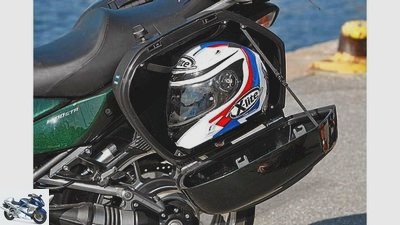
16/21
Large and practical: more capacity than the BMW – and almost as easy to load.

17/21
The water is omnipresent and makes the cities along our route into very special attractions.
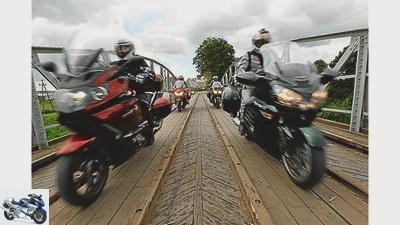
18/21
Bridges cross our path. Here in Riga.
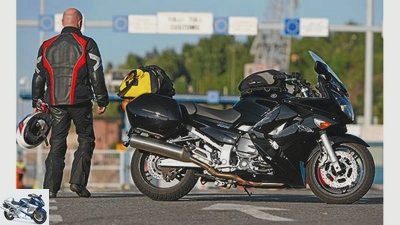
19/21
The Yamaha FJR 1300 A.
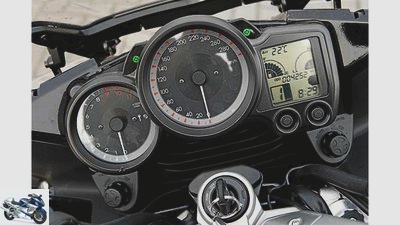
20/21
Clear, but limited: the Yamaha cockpit provides the travel basics. Operation via push buttons.
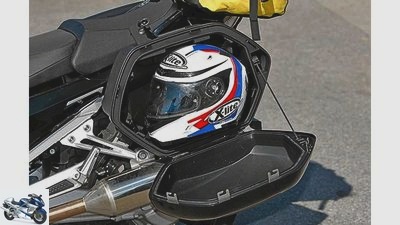
21/21
Just like that: A helmet fits in the Yamaha case. Not much more, with a capacity of just 30 liters.
Comparison test Tourer, BMW K 1600 GT, Honda Pan European, Kawasaki 1400 GTR, Yamaha FJR 1300
Tourers from BMW, Kawasaki, Yamaha and Honda in comparison
The 25th degree of longitude runs right through Helsinki and just past the Estonian capital Tallinn, the most easterly point that MOTORRAD reached in its big tour test. The story of a seven-day trip around the Baltic Sea with the tourers: BMW K 16000 GT, Kawasaki 1400 GTR, Yamaha FJR 1300 A and Honda Pan European.
D.he Baltic Sea – for most Germans it is somewhere between Kiel and Rostock, between the beginning and the end of the holiday, between the beach castle and bathing suit. Adventurers come to Bornholm or Usedom, but at the latest there the German travel industry usually comes to an abrupt end. Around the Baltic Sea – that sounds like a day trip. And that’s how we understood it. At the very beginning.
“Then you can drive around it right away.” Gert Thole, MOTORRAD test boss and rumored master of extensive latifundia in northern Germany, habitually thinks in other dimensions. This momentous sentence, for example, came up after a quick look at the map of Europe in the editorial hall. The reason for the geographic excursion: route planning for this year’s tour test for the new BMW K 1600 GT. For once it shouldn’t go to the Alps, yes, not even to the mountains. But to the sea. But not the ones in the Bay of Lubeck or the seaside resort of Binz. Danzig, Riga, Tallinn, or the Baltic for short, were on the route plan. In the end, even Saint Petersburg, this pearl of the east. Or Helsinki, because Gert was right. Once you are that far in the northeast, it makes little difference whether you drive the same route back. Or you can take the northwest route and check Scandinavia as well.
Buy complete article
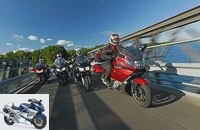
Comparative test tourer
Tourers from BMW, Kawasaki, Yamaha and Honda in comparison
K 1600 GT delivered with top case (49 liter capacity). Together with the two suitcases (2 x 33.5 liters) there is plenty of storage space that Jorg uses down to the last cubic centimeter. The other two travel steamers (namely the Honda Pan European and the Yamaha FJR 1300 A, because our Swedish colleague Mats will only join us in Rostock with the Kawasaki 1400 GTR) are given a roll of luggage for reasons of equal treatment, but also because of absolute necessity. All of this needs to be lashed well and, above all, watertight, because heavy seas await us on the motorway as far as Rostock. Rain, rain, rain – in the northeast, land has been popular for days.
The water is omnipresent and makes the cities along our route into very special attractions.
Meanwhile, the first significant differences are already apparent when packing. The painted Yamaha luggage rack is extremely sensitive, especially on a black motorcycle, and would have to be wallpapered before the luggage roll is lashed. And rear luggage hooks are completely missing, so that the plastic fender has to serve as a fixed point for the tensioning straps. The diamond-like shape of the case is also impractical (a laptop, for example, only fits in with difficulty), and the locking mechanism looks limp. In this regard, Honda and BMW are about to show who is a real travel professional here. The Honda with a plastic-covered luggage rack, luggage hook and a massive locking mechanism. And the BMW with – yes, with all the know-how that the people of Munich have acquired over many years of long-distance travel experience. In the case of the K 1600 GT, this includes, in addition to the easy handling and the cheaper pack size of the case, a practical, remote-controlled central locking system and even a light in the topcase lid. The price for this is high, however: the Munich-based company is charging a whopping 850 euros extra for the top case alone, while Kawasaki, for example, only charges 196 euros for an insignificantly smaller component.
But only marginally. Much more decisive in this test field are differences that become apparent even without extensive price list research. For example the fact that rather short people like fellow editor Rolf automatically feel drawn to the Yamaha or Honda, and certainly not to the mighty BMW. To be clear: the K 1600 GT is initially shocking due to its sheer size. Is hardly maneuverable for less experienced travel fans or women without a good measure of physical strength while standing. In addition, the FJR 1300 A in particular looks extremely delicate, is more of a sports tourer and even a Honda Pan European, which never stood out for its dwarf-like dimensions, seems to be shrinking next to the BMW. No question about it, the K 1600 GT has not only succeeded in advancing into new touring dimensions in terms of the number of cylinders.
As is customary with Bayern, this of course also applies to the price. 24,470 euros including the various extras, i.e. the 850 euros “safety package” (traction control, tire pressure control, adaptive cornering lights) and the 1120 euros “comfort package” (ESA chassis, central locking and anti-theft alarm system), plus that Audio system for 1100 euros, the navigation device for 650 euros and the topcase. The attentive reader should keep this sum in mind when reading the following. And now and then compare it with what the competition is calling. They are not nearly as diverse, but with around 17,000 euros they are also in completely different price regions, which should have a significant impact on one or the other purchase decision well before a possible test drive. This is a shame as the way out of the underground car park already teaches you that nothing is what it seems. Or, in Bavarian terms: a BMW never drives as it looks. But usually much, much better.
Bridges cross our path. Here in Riga.
The K 1600 GT is no exception. Light-footed, she takes the pitfalls that downtown Stuttgart has to offer under her fat wheels. Easy to steer in, fall neutrally at an angle and simply filter away potholes and tram tracks. The only thing your driver struggles with is their size. Meandering through to the front row requires courage, especially the FJR 1300 A, but also the Pan European, are much easier and collect a big plus point. The K 1600 is only partially suitable for commuting to work in the city center.
But that’s not what this is supposed to be about. 4,500 kilometers in seven days – that’s 643 kilometers a day. A distance where other things count than urban traffic jam behavior. The first stage from Stuttgart to Heilbronn on the A 81 is a good example of this. Almost continuously limited to 120, the (standard) cruise control of the fat K celebrates a successful debut. But not only here, but later on the endless stages from Gdansk to Riga or from Stockholm to Trelleborg we will still gratefully use his services, while the other three tourers do not deliver anything like that for money or good words. A real shortcoming that prompted Rolf to mount a throttle rocker adapter for the ball of his hand on the way back. Not an elegant, but a helpful solution.
But back to the German highways. And to the German summer weather. A nightmare – even with heated grips, which are standard equipment on all travel steamers. And at the latest on the A 71, in the highlands of Thuringia, can also be used by everyone. 12.5 degrees and continuous rain: Even purists capitulate, while Jorg is happy about the standard seat heating in the back of the BMW. Meanwhile, his chauffeur enjoys the great weather protection that keeps you largely dry even over longer distances. In this respect, only the Honda can keep up, behind whose powerful windshield you sit even more protected than on the BMW. However, in this bad weather there is nothing else to do than to lower the windows at least so far that you can see over the upper edge, because otherwise you would be flying blind without a windscreen wiper. This, in turn, is easier on the K 1600 GT because the lens is cut out heavily towards the center and therefore exposes the field of vision more easily. On the other hand, even dwarfs look over the FJR disc even in the uppermost position. With corresponding consequences for the wind and weather protection.
But enough of this sad chapter. In the evening around 6 p.m. we are at Rostock city harbor, colleague Mats has been there with the kawa for hours. The suitcases held tight across the board, which cannot be said of gloves and boots consistently. So, the next test for man and material is waiting on Sunday morning. But especially for Jorg. From Rostock towards Greifswald, deserted motorways, always straight ahead. Full throttle – and the old knowledge that fat tourers in full regalia can only do that to a limited extent. Even the brand new K 1600 GT with a topcase shows a pronounced fickleness beyond 220 km / h, as does the 1400 GTR without a topcase, which runs faster in fifth gear than in the long overdrive sixth. This time again, however, the Pan European knocks out the bottom. Anyone who drives behind the commuting ship has to laugh, although it is so sad. From 220 km / h (much more is not possible with the measured 116 hp V4 anyway) even brave touring riders turn the tap off – no matter how hasty they are. Sometimes it becomes uncomfortable before. Only one thing helps: take a passenger with you. Amazingly, there is then largely calm. Which makes it clear where Jorg spends most of the morning.
Apropos pillion: BMW and Honda collect plenty of sympathy points in the second row. Not only because they offer the most comfortable seats with the most relaxed knee angle, but also because the wind protection of their mighty windows has an effect up to the second tier, while it shakes the passengers on the Kawa and Yamaha vigorously. On the other hand, the Yamaha shines again with the best driving stability, even with suitcases and a roll of luggage rushes over the deserted motorway at 260 km / h (according to the speedometer).
Not quite as fast, but it goes quickly towards Poland. We have to go meters, because behind the border there are hundreds of kilometers of country roads waiting for us. And one or the other surprise.
BMW K 16000 GT, Kawasaki 1400 GTR, Yamaha FJR 1300 A and Honda Pan European.
Ferries, for example, because there are no bridges. And before that, long queues. Fortunately, motorcycles enjoy special treatment here. This is not the case in the countless seaside resorts without a bypass. In between, holey coastal roads and a lot of traffic. We achieve minimal consumption (which can hardly be pushed below five and a half liters) and minimal average speeds. And – and that’s the worst – we also enjoy minimal sea views. The forest or a house front is always in between. A Baltic tour without the Baltic Sea from Swinoujscie to Gdansk. No, we didn’t think so.
Especially since we realize that the next day won’t go any better in this regard. Konigsberg, the last corner of Russia in the Baltic States, draws us a thick line, or rather, an impermeable border across the country. Visas, customs formalities, long waiting times: we can do without that and instead give preference to the Masurian Lake District. And learn all kinds of things about the chassis qualities of the big ships on the avenues there. The Kawasaki, for example, does justice to its overall more sporty orientation, springs and dampens more tightly than comfortably and draws attention to itself in sloping position on bumps through a turning behavior that takes getting used to and a large erection moment. The Yamaha is noticeably more comfortable, but above all more neutral to work, conveys clear feedback and comes to life the tighter and trickier the course gets. The Honda surprises with a healthy basic hardness and a certain roughness in response, but absolute neutrality (here the narrow rear tire in the unusual 170 format has an extremely positive effect) and amazing handiness. And the BMW combines – supported by the ESA chassis that can be selected at the push of a button between comfort, normal and sport as well as the load status – and the BMW Duolever – all the advantages. Is not even close to being cracked by the others in terms of comfort, floats in the softest mode like a litter over the wrinkled asphalt, without losing precision or light-footedness. There is no question at all: what technology the Munich-based company has to offer is unique and of such great practical use that it even justifies a hefty surcharge.
The same can be said about the infotainment qualities of the K 1600 GT just a few hundred kilometers away. Lithuania: The landscape and road conditions have completely changed. Especially European roads with deep truck ruts instead of idyllic avenues, 120 km / h boredom instead of varied ups and downs. Right and left endless grain fields, in front of us the wide horizon. What do you do? Enter the cruise control on the BMW and turn on the radio. Or the iPod, safely stowed in the right side panel compartment. Or you can dedicate yourself to the astonishing display and its innumerable information options, controlled by the individual rotary push button on the left end of the handlebar. Plays with the navigation system over the conventional clocks in the cockpit, finds out about consumption, tire pressure, range, outside temperatures, or whatever else is worth knowing. This is entertaining and can be described in such detail here because either, as with the Honda, there is no such information (the Pan does not even have a gear indicator) or, as with the Kawa, it is not used or is seldom used because the controls turns out to be too complicated with a single button in the cockpit. Instead, the Kawa offers two other options. The integral brake system can be partially deactivated (K-Brake) and the traction control can be controlled (K-Track) using two buttons in signal color. A possibility of influencing that nobody absolutely needed on our tour. Just as little as the shutdown of the BMW traction control, which is still finely regulated in the continuous rain of northern Germany.
Speaking of brake systems: All of them rely on compound brake systems, but in different ways. While BMW and Yamaha decelerate partially integrally (if you pull the lever at the front, you only brake at the front), Honda and Kawasaki prefer the fully integral solution. When pulling on the handbrake lever, they also brake at the rear, when stepping on the footbrake, all four also slow down at the front. All in all, the K 1600 GT is the most brutal in its work, the Pan European delays in an exemplary manner and with force. The 1400 GTR and FJR 1300 A also brake effectively, but not quite as transparently, which is mainly due to the fact that the Yamaha absolutely needs the foot brake in order to anchor really hard.
Complete, but not user-friendly. The Kawasaki menu cannot be controlled from the handlebars either.
Which brings us to the key word. Riga, the Baltic metropolis, welcomes the hasty tour company with its wonderful old town, pulsating life and beautiful women. We would like to moor longer, but the schedule is relentless. Tallinn is waiting, the capital of Estonia. The ferry to Helsinki doesn’t wait. So continue early in the morning, with only the Yamaha being a bit uncomfortable because of its long-term increased speed in cold start mode. All other engines have impeccable manners, but completely different characters (see power curves on the left). The Honda V4 is a thoroughbred touring engine: it marches decisively and evenly out of the lower speed range at all times, develops its maximum torque at a good 6000 rpm and can be controlled wonderfully stress-free. In contrast to the GTR-1400 power pack. Measured 153 PS strong, but below 3000 rpm (in the fuel-saving Eco mode even up to almost 4000 rpm) no pressure in the lower rev range, above that then full of power – this is not an ideal tour characteristic. The Yamaha quadruplet, which is still convincing after so many model years, shows how it can be done better. Pressure below, performance above: apart from the lack of sixth gear, the FJR 1300 A would hardly be to blame. If so, if it weren’t for this incredible BMW six-cylinder. An engine that can do everything and (except when it comes to consumption, see measured values) towers over all others by miles.
The question is: do you need that? A question that will accompany us on our further trip around the Baltic Sea. In the winding lakes and islands of Finland as well as on the strictly limited highways of Sweden or the high-speed return trip from Rostock to Stuttgart. And depending on the type of driver and the situation (see personal statements), the answer is just as different as the one about perfect ergonomics. For smaller people like Rolf, the Honda fits perfectly, while bigger ones (like the author) can only sit on it because of the lack of knee room if the seat bench is locked in the highest of three positions. Then, however, when the windshield is fully extended, the wind protection is no longer as perfect as it was before (on this occasion: The Pan European and the K 1600 GT are the only ones that can be driven with an open visor or a jet helmet and so much more immediate impressions allow). The thing with the higher seat also applies to the BMW. In the higher of two levels, more comfortable, especially for taller people, but with poorer wind protection. And then practically no longer having to act when maneuvering for average Europeans (like the Swede Mats). And while we’re on the list of deficiencies: The BMW is seriously missing a reverse gear, the Kawasaki a better padded and height-adjustable seat, the Yamaha more wind protection and equipment. And we are clearly asleep after seven days and seven countries.
On Friday around 4 p.m., after exactly 4500 kilometers, we reach the editorial office again. Made it, but happy, and overloaded with impressions. The most important one: traveling educates, and traveling on two wheels is even more educative. Not just calluses in the familiar places. The second insight: The touring world is not standing still, BMW is setting new standards in many areas with the K 1600 GT and is breaking new ground. Everyone has to decide for themselves whether one wants to go along these paths.
MOTORRAD Tourer rating and test result
BMW K 16000 GT, Kawasaki 1400 GTR, Yamaha FJR 1300 A and Honda Pan European.
Tourer rating
| Max points | BMW | Honda | Kawasaki | Yamaha | Draft | 20th | 20th | 17th | 15th | 18th |
| Touring engine characteristics | 20th | 18th | 16 | 13 | 15th | Handling | 20th | 15th | 14th | 10 | 12th |
| Driving stability country road | 20th | 16 | 15th | 12th | 15th | Driving stability Autobahn | 20th | 16 | 6th | 12th | 18th |
| Steering precision | 20th | 17th | 16 | 13 | 15th | Slopes / ground clearance | 20th | 15th | 12th | 14th | 12th |
| Chassis reserves | 20th | 18th | 13 | 15th | 14th | Braking behavior | 20th | 18th | 16 | 13 | 14th |
| Driving comfort | 30th | 26th | 23 | 21st | 23 | Long-distance seating comfort driver | 20th | 18th | 17th | 15th | 16 |
| Long-distance seating comfort for the passenger | 20th | 18th | 17th | 14th | 15th | Wind and weather protection (including ventilation / heating) |
20th | 18th | 19th | 15th | 13 |
| Touring equipment | 30th | 28 | 18th | 21st | 21st | Luggage system | 30th | 27 | 25th | 24 | 23 |
| handling (Turning, maneuvering, jacking up) |
20th | 9 | 12th | 12th | 13 | consumption | 20th | 14th | 13 | 13 | 13 |
| Range | 30th | 20th | 25th | 17th | 20th | Total points | 400 | 331 | 294 | 269 | 290 | placement | 1. | 2. | 4th. | 3. |
Test result
1.BMW K 1600 GT
She is a real all-rounder, can
everything from strolling to the lawn and is clearly the travel queen. But it’s terribly big – and terribly expensive.
2. Honda Pan European
If you want to travel in peace, the Honda is ideal. Your engine pushes evenly, your chassis plays along inconspicuously. Their high-speed commuting, however, is questionable.
3. Yamaha FJR 1300 A
It is a shame that Yamaha has paid so little attention to the FJR in recent years. It’s a great touring base. But it was above all the BMW that passed by mercilessly.
4. Kawasaki GTR 1400
If it’s a tourer for sports riders
gave – it was her. Until the BMW came. For the traditional touring rider, however, there are better offers. See Honda.
Technical data – BMW, Honda
The BMW K 1600 GT.
| BMW K 1600 GT | engine |
| design type | Six-cylinder four-stroke in-line engine | injection | 1 x Ø 52 mm |
| coupling | Multi-disc oil bath clutch | Bore x stroke | 72.0 x 67.5 mm |
| Displacement | 1649 cm3 | compression | 12.2: 1 |
| power | 118.0 kW (161 hp) at 7750 rpm | Torque | 175 Nm at 5250 rpm |
| landing gear | frame | Bridge frame made of aluminum |
| fork | Double longitudinal control arm made of aluminum | Brakes v / h | Ø 320 mm / Ø 320 mm |
| Assistance systems | Partly integral braking system with ABS | bikes | 3.50 x 17; 6.00 x 17 |
| tires | 120/70 ZR 17; 190/55 ZR 17 | Tires | Metzeler Z 8 Interact rear “C” |
| mass and weight | wheelbase | 1618 mm |
| Steering head angle | 62.2 degrees | trailing | 106 mm |
| Suspension travel v / h | 135/115 mm | Seat height ** | 810-830 mm |
| Weight with full tank ** | 342 kg | Payload ** | 198 kg |
| Tank capacity / reserve | 24.0 / 4.0 liters | Service intervals | 10000 km |
| price | 19,900 euros | Price test motorcycle | 24,470 euros *** |
| Additional costs | around 262 euros | MOTORCYCLE readings |
| Top speed * | 250 km / h | acceleration |
| 0-100 km / h | 2.9 sec | 0-140 km / h | 5.0 sec |
| 0-200 km / h | 10.2 sec | Draft |
| 60-100 km / h | 3.7 sec | 100-140 km / h | 3.9 sec |
| 140-180 km / h | 4.1 sec | consumption |
| Test consumption | 5.9 liters / super | Reach country road | 407 km |
| Honda Pan European | engine |
| design type | Four cylinder four stroke 90 degree V engine | injection | 4 x Ø 36 mm |
| coupling | Multi-disc oil bath clutch | Bore x stroke | 78.0 x 66.0 mm |
| Displacement | 1261 cm3 | compression | 10.8: 1 |
| power | 93.0 kW (127 hp) at 8000 rpm | Torque | 125 Nm at 6000 rpm |
| landing gear | frame | Bridge frame made of aluminum |
| fork | Telescopic fork, Ø 45 mm | Brakes v / h | Ø 310 mm / Ø 316 mm |
| Assistance systems | Fully integral braking system with ABS | bikes | 3.50 x 18; 5.00 x 17 |
| tires | 120/70 ZR 18; 170/60 ZR 17 | Tires | Bridgestone BT 020 “F” |
| mass and weight | wheelbase | 1490 mm |
| Steering head angle | 64.0 degrees | trailing | 98 mm |
| Suspension travel v / h | 117/120 mm | Seat height ** | 775-805 mm |
| Weight with full tank ** | 329 kg | Payload ** | 193 kg |
| Tank capacity / reserve | 29.0 / 3.0 liters | Service intervals | 6000 km |
| price | 17450 euros | Price test motorcycle |
| Additional costs | around 170 euros | MOTORCYCLE readings |
| Top speed * | 225 km / h | acceleration |
| 0-100 km / h | 3.6 sec | 0-140 km / h | 6.2 sec |
| 0-200 km / h | 13.9 sec | Draft |
| 60-100 km / h | 4.5 sec | 100-140 km / h | 5.2 sec |
| 140-180 km / h | 5.7 sec | consumption |
| Test consumption | 6.1 liters / super | Reach country road | 475 km |
* Manufacturer information; ** MOTORCYCLE readings; ***Incl. Safety package (850 euros) consisting of DTC, RDC and adaptive headlights; Comfort package (1120 euros) consisting of: ESA II, central locking and anti-theft alarm system; Audio system with preparation for navigation device (1100 euros); Navigation device (650 euros); Topcase (850 euros)
Technical data – Kawasaki, Yamaha
The Yamaha FJR 1300 A.
| Kawasaki 1400 GTR | engine |
| design type | Four-cylinder, four-stroke in-line engine | injection | 4 x Ø 40 mm |
| coupling | Multi-disc oil bath clutch | Bore x stroke | 84.0 x 61.0 mm |
| Displacement | 1352 cm3 | compression | 10.7: 1 |
| power | 114.0 kW (155 hp) at 8800 rpm | Torque | 136 Nm at 6200 rpm |
| landing gear | frame | Bridge frame made of aluminum |
| fork | Upside-down fork, Ø 43 mm | Brakes v / h | Ø 310 mm / Ø 270 mm |
| Assistance systems | Fully integral braking system with ABS | bikes | 3.50 x 17; 6.00 x 17 |
| tires | 120/70 ZR 17; 190/50 ZR 17 | Tires | Bridgestone BT 021 “U” |
| mass and weight | wheelbase | 1520 mm |
| Steering head angle | 63.9 degrees | trailing | 112 mm |
| Suspension travel v / h | 113/136 mm | Seat height ** | 820 mm |
| Weight with full tank ** | 314 kg | Payload ** | 218 kg |
| Tank capacity / reserve | 22.0 liters | Service intervals | 6000 km |
| price | 17,495 euros | Price test motorcycle |
| Additional costs | around 180 euros | MOTORCYCLE readings |
| Top speed * | 246 km / h | acceleration |
| 0-100 km / h | 3.2 sec | 0-140 km / h | 5.2 sec |
| 0-200 km / h | 10.4 sec | Draft |
| 60-100 km / h | 5.6 sec | 100-140 km / h | 5.0 sec |
| 140-180 km / h | 6.4 sec | consumption |
| Test consumption | 6.2 liters / normal | Reach country road | 355 km |
| Yamaha FJR 1300 A | engine |
| design type | Four-cylinder, four-stroke in-line engine | injection | 4 x Ø 42 mm |
| coupling | Multi-disc oil bath clutch | Bore x stroke | 79.0 x 66.2 mm |
| Displacement | 1298 cm3 | compression | 10.8: 1 |
| power | 105.5 kW (144 PS) at 8000 rpm | Torque | 134 Nm at 7000 rpm |
| landing gear | frame | Bridge frame made of aluminum |
| fork | Telescopic fork, Ø 48 mm | Brakes v / h | Ø 320 mm / Ø 282 mm |
| Assistance systems | Partly integral braking system with ABS | bikes | 3.50 x 17; 5.50 x 17 |
| tires | 120/70 ZR 17; 180/55 ZR 17 | Tires | Bridgestone BT 021 “F” |
| mass and weight | wheelbase | 1515 mm |
| Steering head angle | 64.0 degrees | trailing | 109 mm |
| Suspension travel v / h | 135/125 mm | Seat height ** | 790-810 mm |
| Weight with full tank ** | 305 kg | Payload ** | 198 kg |
| Tank capacity / reserve | 25.0 liters | Service intervals | 10000 km |
| price | 16,995 euros | Price test motorcycle |
| Additional costs | around 230 euros | MOTORCYCLE readings |
| Top speed * | 245 km / h | acceleration |
| 0-100 km / h | 3.3 sec | 0-140 km / h | 5.4 sec |
| 0-200 km / h | 11.0 sec | Draft |
| 60-100 km / h | 4.4 sec | 100-140 km / h | 4.5 sec |
| 140-180 km / h | 5.2 sec | consumption |
| Test consumption | 6.2 liters / normal | Reach country road | 403 km |
* Manufacturer information; ** MOTORCYCLE readings
Related articles
-
BMW, Kawasaki, Triumph and Yamaha Tourer in comparison test
Gargolov 31 photos Gargolov 1/31 Tourer comparison test: Triumph Trophy SE, BMW R 1200 RT, BMW K 1600 GT, Yamaha FJR 1300 and Kawasaki 1400 GT. Gargolov…
-
BMW R nineT, Moto Guzzi Griso 1200, Yamaha XJR 1300 and Honda CB 1100 in comparison
www. 38 photos www. 1/38 The eerie attraction that the BMW R nineT, Moto Guzzi Griso, Yamaha XJR 1300 and Honda CB 1100 trigger…
-
Honda CB 1000 R, Kawasaki Z 1000 SE, Yamaha FZ1 in the test
www. 48 photos www. 1/48 On the MOTORRAD test tracks in southern France, Honda’s CB 1000 R and Yamaha’s FZ1 are ready to test…
-
fact Concept comparison Honda CBR 1100 XX Kawasaki ZX-12 R Suzuki GSX-R 1000 Suzuki GSX 1400 Yamaha FZS 1000 Fazer Yamaha FJR 1300 Six bombs The six …
-
Comparison test: BMW K 1300 GT, Kawasaki 1400 GTR, Yamaha FJR 1300 A
Gargolov comparison test: BMW K 1300 GT, Kawasaki 1400 GTR, Yamaha FJR 1300 A Large tourers in Corsica In the tourer segment, there is hardly a path to the …
-
Comparison test Suzuki SV 650, Honda CB 650 F, Kawasaki ER-6n, Yamaha MT-07
www.bilski-fotografie.de 34 pictures www.bilski-fotografie.de 1/34 They are the hottest candidates among the middle class naked bikes ….
-
Comparison test sports tourer Kawasaki Z 1000 SX Tourer, Triumph Sprint GT
www. 35 pictures www. 1/35 Sports tourers sit between all chairs, but the temptation lies in this niche: there are bikes, …
-
Comparison test touring enduro bikes: Honda Transalp, Kawasaki Versys, Suzuki V-Strom 650
Jahn comparison test travel enduro: Honda Transalp, Kawasaki Versys, Suzuki V-Strom 650 Always on the wall, travel enduro does not necessarily mean BMW …
-
Luxury tourer comparison test BMW K 1600 Grand America and Honda GL 1800 Gold Wing Tour DCT airbag
17 pictures 1/17 BMW K 1600 Grand America and Honda GL 1800 Gold Wing Tour DCT airbag in comparison test. 2/17 …
-
Gargolov comparison test big bikes: Honda CBR 1100 XX Super Blackbird, Kawasaki Ninja ZX-12R, Suzuki GSX 1300 R Hayabusa, Yamaha FJR 1300 A Two fast, Two …